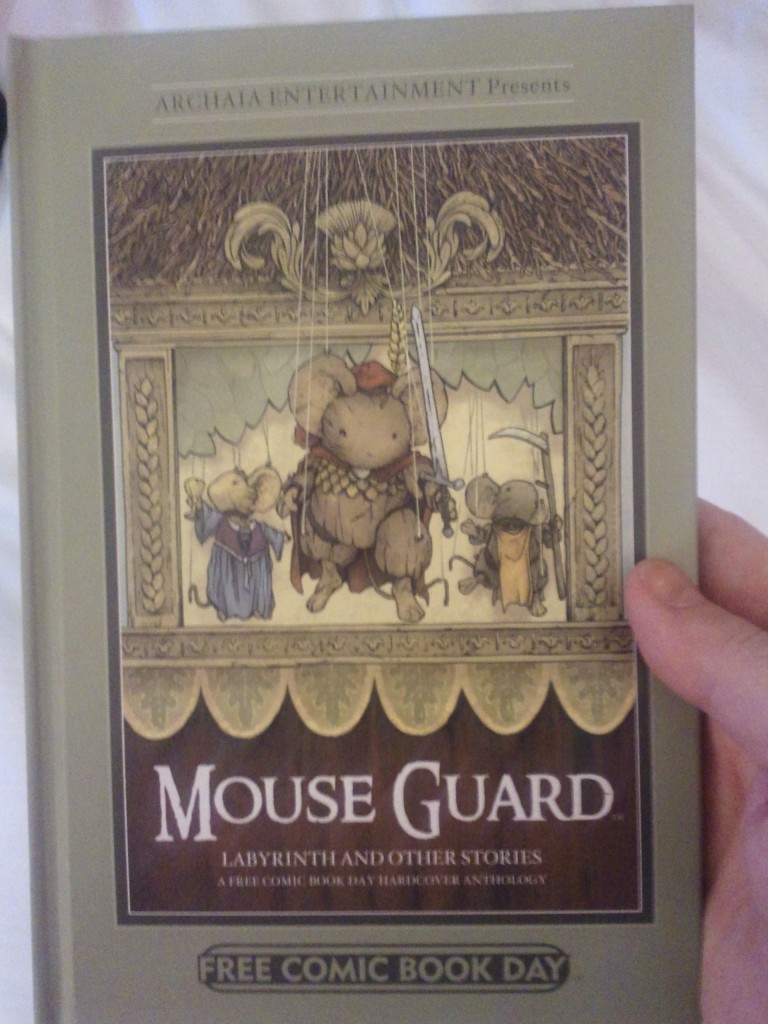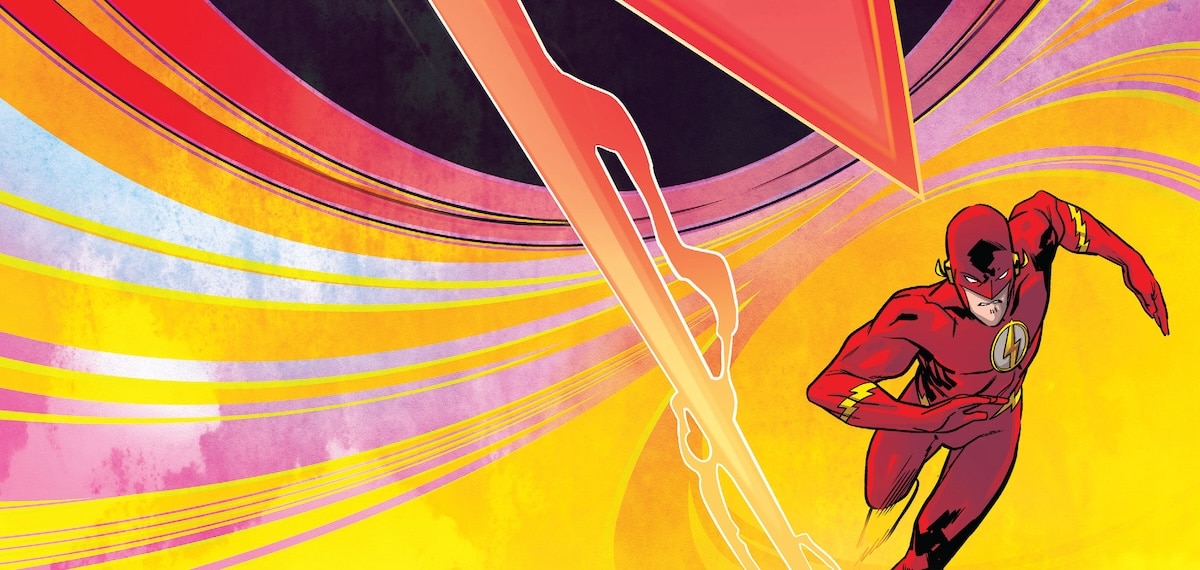.
There was a lot of cool stuff seen yesterday at the Diamond Retailer Summit, including black-and-white artwork from Before Watchmen. But what got my juices flowing was something the fine folks at Archaia handed me:
This is their 2012 Free Comic Book Day issue. Many comicsologists were amazed when they announced that the “free” comic they would offer this year would be a hardcover book! Usually, that free comic is the equivalent of a $2.99 comic book (and some publishers have given out an actual issue of a regular series).
So this is it. It’s comic book sized. It’s 48 pages of full color comics (some are in black-and-white). Forty-three pages of story.
And it costs retailers thirty cents a copy.
Granted, Archaia has to limit the number available, as they are losing some money on the copies sold. So, naturally, I asked what the suggested retail price would be on such a book.
Five dollars.
Let’s factor that cost, just so you can see why I was so gobsmacked.
A similar, everyday comic of that size costs $3.99. Usually there might be 40 pages of story, with advertising. Fans routinely complain about the cost, as the added story pages are not a “satisfying chunk” of entertainment… that is, not worth the extra one dollar in price.
So here we have $4 comic, with a nice cover and binding, for one dollar more. No advertising, aside from two pages showcasing the graphic novels, and the typical “meta” pages you find in a typical book (title page, table of contents, creator biographies). Normal book readers don’t notice or complain about such pages. (Seriously… graphic novels run ads in the back all the time, showcasing the creators’ other titles, as well as related genre titles.)
So, comics fans, would you be more likely to purchase a nice hardcover binding than a magazine binding, if the content justified the price? Would you buy an annual or a special one-shot if it had this binding?
Retailers, would you stock and sell such editions? Would it be easier to handle the back issues if you could shelve them like a regular graphic novel? Do you feel that “waiting for the trade” would be discouraged with such an edition?
Librarians, would you buy periodicals in library bindings? Would you shelve them as books, or as magazines? Educators, what do you think about this edition?
Publishers, distributors, creators; would you design and market such an edition? Does this hearken back to the square-bound prestige format popular in the 1980s and 1990s? (Dark Knight Returns, Excalibur: The Sword is Drawn, Elseworlds) Do you think there is a market for a hardcover comic book?
Myself, I hope more publishers pursue this. It takes a lowly comic book periodical, and turns it into a book! People are less dismissive of comics if it looks like a book. And that’s the first hurdle: perception. Get past that, get them to read it with few preconceptions, and the battle for the reader’s heart and mind is halfway finished!





My bookshelves say “nay nay”. Storage is already an issue at the Casa de Maxwell. Great for collected editions, I suppose, but terrible for monthly issues.
I might feel different after coffee, but I have a hard time really believing that.
I received an advance copy of the Archaia FCBD book this week, and it’s a snazzy and impressive piece of work.
I would gladly buy a comic in this format.
I think this is marketing genius! How much did Archaia spend all told? Whatever it was, it catapulted them to the upper reaches of comics innovators, while getting them press and probably new readers and brand awareness. And they put out quality titles. Nicely done.
I know what im getting FCBD! but all things floopy will become PDFs in at least 5-10yrs and GNs and TPBs will be more premium editions.
they already do this in europe ( they are bigger though and cost more) but the books are not monthly. and most series are only a few books long not hundreds. so maybe the U.S. should get out of the soap opera of super heros and get more into the novel format of Europe? might be better to go this route? I think we should. it looks great and would hopefully generate some new great stories and talent.
Besides i have no idea how they can afford to do a full color book hardcover for $5 retail. whose their printer!
I would be strangely okay with this idea. A comic twice as long as a regular comic with good binding (even if it’s a paperback bind) for $5? Makes sense to me.
Give me 40-50 pages of serial content, bind it well enough that it looks good on a bookshelf, and sell it at a reasonable twice (less than what two comics of a similar total page count). Makes good business sense.
Bear in mind that Neil Gaiman’s Violent Cases is about that long and quite a bit more expensive.
Bear in mind that Bendis’s Takio was $10 for about 100 pages of story content.
Bear in mind that specials like the Miller/McFarlane Spawn/Batman thing were generally a little pricier than that for not much more story.
I think it’s a great idea. I wish more publishers and creators would use the format.
For retailers, sure it would be nice be able to display on a shelf in any capacity over time, but would the thickness of a hardcover limit the amount they can stock if a store only devotes one facing to a book? And how much of an increase in shipping costs would there be with the added weight?
I do think this would work better with more self-contained one-shots, annuals, or specials and not so much with a monthly series. I can imagine something like DC’s “Solo” in this format.
As a general rule, my preference is always a monthly paper “floppy” soft-cover saddle stitched/stapled comic book.
But it’s great that the format can be experimented with, and these 48 page hardcovers from Archaia look like fascinating art objects.
If you’re going through the trouble of making paper artifacts, you might as well have some fun with it.
Yes. Yes please. This is such a great way to get comics out to a larger audience – you nailed it with “perception”. I hope this continues to grow.
I would gladly buy this format for stories I was buying anyway. It would presumably reduce the temptation to double-dip for a TPB or hardcover edition later. Most of my favorite series in the last few years have either been coming out in as standalone “books” (Scott Pilgrim, 20th Century Boys) or I’ve been buying them that way (e.g. The Unwritten).
That looks just wonderful. My only caveat is that in order to get the (retail) price down to $5 they probably need to print a pretty large number of them.
I can’t help but wonder how the books would fit into the direct market system, in which you print to match the number of pre-orders. If the number of pre-orders was much less than the minimum printing that’s needed to get the $5 price, well then it seems like you’d have to either cancel the book, or pay for a larger printing than you can support with your orders, and a publisher could probably not do that with every book. Or not for very long, any way.
Hell yes I’d buy it. Looks great!
The main logistical problem is that comics are printed and shipped in relatively short turnarounds from North American printers…which are expensive, but practical.
If you want to get really cheap hardcovers like that as a regular thing, you’ll have to print them in Asia 3-5 months ahead of release date, and then have them shipped on a boat around the world. Airfreight is expensive as hell for books. You’d need to print 2-5k minimum to make it worth your while.
I do think having comics bound like books, even in the fake hardcover side sew things that are popular for comics would help them, but i would HATE having a 5 issue arc in individual hardcovers.
also, the staple bound floppy comic book is the cheapest printed booklet that can be produced in printing..and its tough for those to be profitable in this market especially for indies.
Making em hardcovers seems like it would just kill any profit margins off, unless you raise prices and i don’t see that working very well.
I do not see people coming in to stare at a shelf of 100+ small (this book isn’t regular comic book size, btw) hardcovers a week, so no, this isn’t the future of the floppy. I could see it being a nice, occasional addition, however. But not a replacement.
Marvel and DC can’t offer stores 30+ of these a week of all-new material at a 55% discount.
I would buy these, but only if it contained a complete story. There’s no way I’d buy a typical “Part 5 of a 9 part story” in this format.
I’m interested to know the actual production costs of this style vs. the traditional, frail floppy style. Which is more profitable and if it’s not the floppy then why? That might be more telling than anything.
Digital comic, plz.
It’s like a smaller European graphics novel. I’d buy for sure.
I would gladly stock them. As long as they sell.
I think part of the lower than normal production cost for each book is the fact that it’s being printed in a very large quantity for a big free giveaway event. If it was book released on a normal Wed, with a retail price, then orders would be much lower and the printing cost per book would be much higher.
That said, it is a great marketing idea on Archaia’s part. Even in bulk, these will disappear fast and not not meet the demands, meaning you’ll be seeing these sold for big bucks later on ebay. The titles in the book fit the family friendly atmosphere of FCBD and hopefully lead to big sales for said titles.
Its a great idea. Considering a lot of children books are this exact format (40 pages or less with hardcovers) but usually around the 8-12 dollar range.
I support anything that is different and pushes the boundaries on what is normally accepted for this stagnant medium. I would buy this definitely.
These will be rare, and highly sought after. Consider nabbing one while you can on FCBD.
I love the generosity of the publisher and retailers who commit to getting this to us. Although of course I may never get a copy.
I think this hints at the greater potential of FCBD, where you get specially released trades with special FCBD covers, etc.
Then comes “ALMOST Free” CBD, etc.
I’m waiting for the day when all comics will be “print on demand” and we can all create our own anthology hardcovers.
Between this and Larsen’s 2010 proposal, I’m in. http://www.comicbookresources.com/?page=article&id=24545
I think people are overlooking the most important quotient in this formula: the content. Would I pay $5 for a forty-page hard cover Mouse Guard? Absolutely. Would I pay the same for a like treatment of most other comics? Absolutely not. Silk purses from pigs ears and such. I’m only going to shell out the extra buck for a swell treatment of an extra-special effort, not for the run-of-the-mill or less.
…and I like saipaman’s idea of custom made POD hardcovers. I second the proposal.
I would definitely buy something like that. I’m generally buy trades not monthly comics, as anything I buy I rather be able to put it up on a shelf rather than put it away into a comic box and forget about it.